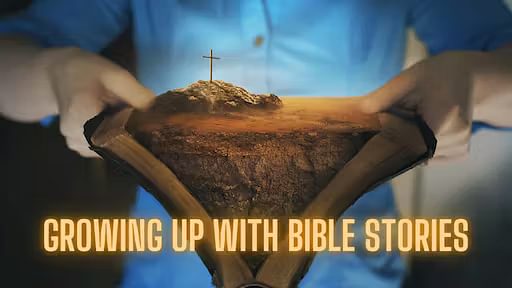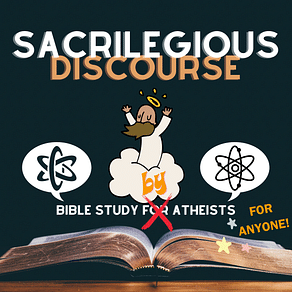Hi, I’m Andrian (not my real name), and I was raised in a deeply religious Christian Fundamentalist household. The Bible played a central role in my early life, but, as anyone who has read the Bible knows, there’s a lot of stuff in there that’s not very kid-friendly! I’d like to share how the Bible was presented to me when I was a kid, and how the various difficult issues were dealt with.
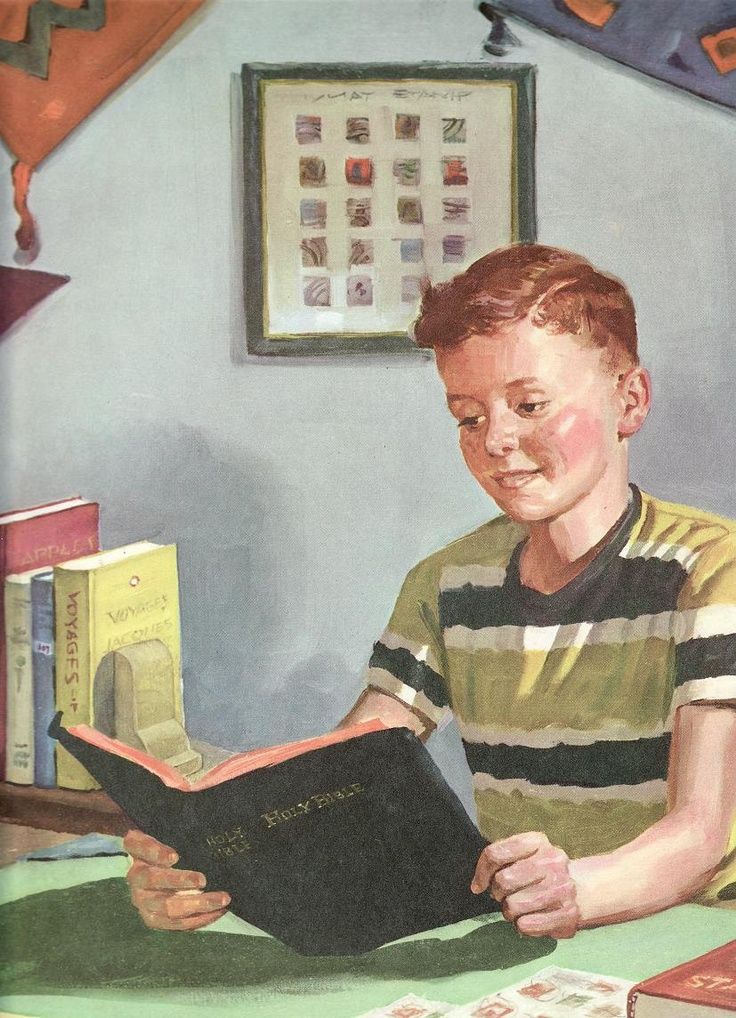 My religious training started young. About as soon as I was old enough to appreciate being read to and listening to stories, my parents got me a set of dramatized Bible story tapes that they would play for me at bedtime and whenever else I wanted to listen to them. My family also read Bible stories to me from books designed to tell the stories in a more kid-friendly way, with plenty of pictures depicting the scenes. Much of the media I was exposed to during my childhood, growing up in the ‘90’s, had been produced in earlier decades, and a lot of the most notable pieces of media had a very ‘50’s vibe to them. I don’t know the actual publication dates, but it all had a “Leave it to Beaver” sort of aesthetic. The illustrations in the books were often hand-painted, and when they depicted modern people, they were usually dressed like they were in their “Sunday best.”
My religious training started young. About as soon as I was old enough to appreciate being read to and listening to stories, my parents got me a set of dramatized Bible story tapes that they would play for me at bedtime and whenever else I wanted to listen to them. My family also read Bible stories to me from books designed to tell the stories in a more kid-friendly way, with plenty of pictures depicting the scenes. Much of the media I was exposed to during my childhood, growing up in the ‘90’s, had been produced in earlier decades, and a lot of the most notable pieces of media had a very ‘50’s vibe to them. I don’t know the actual publication dates, but it all had a “Leave it to Beaver” sort of aesthetic. The illustrations in the books were often hand-painted, and when they depicted modern people, they were usually dressed like they were in their “Sunday best.”
Speaking of Sundays, I suppose I should note that I was raised in a Seventh-Day Adventist church. The most important thing to know about them is that they attend church on Saturday instead of Sunday, and have some very particular rules about what can and cannot be done on that day of the week. The entire day is supposed to be dedicated to worshiping God, which meant that there could be no secular entertainment, apart from nature  documentaries, no work, and no forms of play that were too much like the kinds of media that were forbidden. In my household, there were a number of “Sabbath games” that we could play. There were a set of nature-based card games which were essentially Go Fish but with mammals and birds. There were board games based around Bible stories, such as Egypt to Canaan, in which your pieces represent the Israelites traveling through the wilderness to the Promised Land. In case you’re wondering, yes, there was a loop your pieces could get stuck in to represent the 40 years of useless wandering. There were also lots of Bible trivia games, as well as a Bible-themed Pictionary clone. Mostly, though, Saturdays were boring and stressful, with everyone trying to be on their best behavior and parents constantly watching over your shoulder to make sure you were following the rules. Despite all the attempts to make Saturdays fun, they rarely were, and I always looked forward to sundown, when my life could return to normal.
documentaries, no work, and no forms of play that were too much like the kinds of media that were forbidden. In my household, there were a number of “Sabbath games” that we could play. There were a set of nature-based card games which were essentially Go Fish but with mammals and birds. There were board games based around Bible stories, such as Egypt to Canaan, in which your pieces represent the Israelites traveling through the wilderness to the Promised Land. In case you’re wondering, yes, there was a loop your pieces could get stuck in to represent the 40 years of useless wandering. There were also lots of Bible trivia games, as well as a Bible-themed Pictionary clone. Mostly, though, Saturdays were boring and stressful, with everyone trying to be on their best behavior and parents constantly watching over your shoulder to make sure you were following the rules. Despite all the attempts to make Saturdays fun, they rarely were, and I always looked forward to sundown, when my life could return to normal.
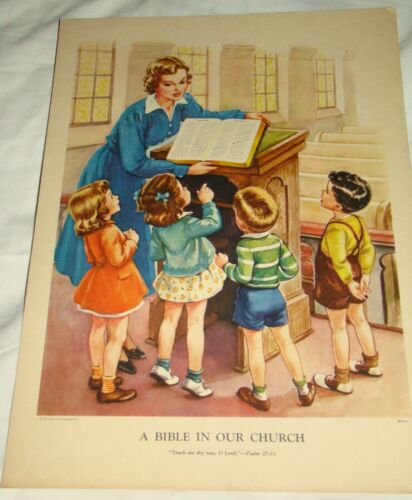 Creating Bible-themed media for kids is tricky. As Husband and Wife have noted throughout the course of their podcast, a lot of Bible stories include sex and violence, and the Bible itself is written in a particularly boring style, droning on and on about about who begat who and what kind of cloth to decorate the tabernacle with, but then glossing over many of the interesting parts of the stories. This means that Bible media for kids has to be heavily altered from its original version in order to hold their attention and not traumatize them. Different publications and organizations will do this in different ways.
Creating Bible-themed media for kids is tricky. As Husband and Wife have noted throughout the course of their podcast, a lot of Bible stories include sex and violence, and the Bible itself is written in a particularly boring style, droning on and on about about who begat who and what kind of cloth to decorate the tabernacle with, but then glossing over many of the interesting parts of the stories. This means that Bible media for kids has to be heavily altered from its original version in order to hold their attention and not traumatize them. Different publications and organizations will do this in different ways.
On one end of the spectrum, there’s media like VeggieTales, which take a lot of artistic liberty with the stories, and usually replace the violence with things like throwing slushies and pies at one another. The one exception to this is the story of David and Goliath, where David does actually hit Goliath with a rock and kill him, though not very much time is spent dwelling on the fact that Goliath is dead. Other media publishers take a similar approach, telling only the most kid-friendly stories in the most sugar-coated ways they can. This is the approach usually used for media aimed at younger kids.
On the other end of the spectrum, there’s media like The Prince of Egypt that’s willing to tell the stories in a more mature and less-sanitized way. This media will often include the violent parts of the Bible, but only those violent parts where they can spin the ones being harmed as either the innocent victims of godless villains, or wicked people who deserve what they get. The “good guys” in these stories will never do things like take slaves. They can have character flaws, but these will usually be punished within the telling of the story, leading to their repenting and learning their lesson.
 A story that illustrates the differences between these two approaches well is the story of Noah’s Ark. In the more sugar-coated media, there will be little to no mention of anyone drowning. All the focus will be on God protecting Noah and the animals, and there probably won’t be any animal sacrifices at the end of the story. Instead, Noah will just pray to thank God under a rainbow while the animals spread out across the land. In the more mature media, however, they will admit that people and animals die in the flood. Often, Noah is depicted as preaching to his wicked neighbors, trying to convince them to join him on the Ark. His neighbors will usually mock him, and may even attempt to sabotage the building of the Ark. Then, when the rain starts falling, the people will bang on the door, begging to be let in, but Noah cannot open the door, either because it’s unsafe, or because God has forbidden it, or because he physically can’t do it. In this latter case, the only one who can open and close the door of the Ark is God or one of His angels. The sacrifice of the animals may be depicted, but not graphically. Usually this kind of media merely depicts an altar with fire on the top and no discernable animal shape in the middle. Neither kind of media will include the story about Noah getting drunk and Ham seeing him naked. If that part of the story is ever told, it’s saved for teenagers, and is more part of a serious Bible study than entertainment media.
A story that illustrates the differences between these two approaches well is the story of Noah’s Ark. In the more sugar-coated media, there will be little to no mention of anyone drowning. All the focus will be on God protecting Noah and the animals, and there probably won’t be any animal sacrifices at the end of the story. Instead, Noah will just pray to thank God under a rainbow while the animals spread out across the land. In the more mature media, however, they will admit that people and animals die in the flood. Often, Noah is depicted as preaching to his wicked neighbors, trying to convince them to join him on the Ark. His neighbors will usually mock him, and may even attempt to sabotage the building of the Ark. Then, when the rain starts falling, the people will bang on the door, begging to be let in, but Noah cannot open the door, either because it’s unsafe, or because God has forbidden it, or because he physically can’t do it. In this latter case, the only one who can open and close the door of the Ark is God or one of His angels. The sacrifice of the animals may be depicted, but not graphically. Usually this kind of media merely depicts an altar with fire on the top and no discernable animal shape in the middle. Neither kind of media will include the story about Noah getting drunk and Ham seeing him naked. If that part of the story is ever told, it’s saved for teenagers, and is more part of a serious Bible study than entertainment media.
 In addition to entertainment media, kids are also given more formal Biblical instruction. The most common form of this is Sunday (or in my case Sabbath) School. This can occur before or after the sermon, during which time everyone splits up into groups based on age. While the structure and curriculum of these classes varies from denomination to denomination and church to church, the churches I attended should be fairly representative of the most common trends, at least among Protestant churches. I don’t really know what goes on in Catholic churches, as I have never attended one. For younger children, these classes involve singing songs, hearing a Bible story told by the teacher, doing a craft (usually related to the story), and possibly being given a Memory Verse.
In addition to entertainment media, kids are also given more formal Biblical instruction. The most common form of this is Sunday (or in my case Sabbath) School. This can occur before or after the sermon, during which time everyone splits up into groups based on age. While the structure and curriculum of these classes varies from denomination to denomination and church to church, the churches I attended should be fairly representative of the most common trends, at least among Protestant churches. I don’t really know what goes on in Catholic churches, as I have never attended one. For younger children, these classes involve singing songs, hearing a Bible story told by the teacher, doing a craft (usually related to the story), and possibly being given a Memory Verse.
A Memory Verse, as the name implies, is a passage of the Bible which kids are expected to memorize. For younger children, this is usually a short and simple passage, but older children may be expected to memorize several verses, or even an entire chapter. These passages are always selected from the more pleasant parts of the Bible, and usually contain some kind of lesson or instruction that the teachers want the students to memorize.
As the kids get older, they will graduate to higher classes, which gradually place less emphasis on the singing and crafts and more on the Bible study. Instead of the teacher telling a story, kids may be expected to take turns reading parts of a selected chapter until they have read the whole story. Some lessons, instead of focusing on a story, will focus on a theme, such as kindness, obedience, or telling the truth. Whatever the case, the parts of the Bible being taught will be selected to be appropriate to the age group and to tell a consistent narrative. Some Sunday/Sabbath Schools will use published curricula, while in others the teachers make up their own.
What is considered “age-appropriate” will vary from congregation to congregation. Some have no trouble telling stories about bears mauling children to death or women driving spikes through the temples of sleeping men. Others will avoid these topics. In my case, I was taught many of these stories, though the most unpleasant ones were still left out, such as the story in Numbers 31 where Moses orders the Israelites to kill and enslave prisoners of war. Often, the unpleasant stories will be abridged or censored, and other times, the lesson will revolve around teaching the children why it was okay for God to order the Israelites to wipe out entire people groups or do other horrible things. I was taught these sorts of apologetics from early on, and even now I have to be careful to not let the fanciful embellishments included in the children’s versions of the stories cloud my view of certain Bible stories.
As they get older, in addition to the Memory Verses, kids will also be expected to memorize certain lists of things from the Bible. These include things like the days of creation, the names of Jacob’s twelve sons, the Ten Commandments, the names of Jesus’ disciples, the Fruits of the Spirit, and the Armor of God. These are often accompanied with visuals, and sometimes even songs to aid with the memorization. Many of these also make good crafts and coloring pages.
On special occasions, classes may prepare a song or a play that they can perform in front of the congregation. These occasions are usually timed to occur close to major holidays, such as Christmas or Easter, and will be themed accordingly.
 During the summer, many churches will hold a Vacation Bible School, often shortened to VBS. A VBS functions as a sort of expanded Sunday/Sabbath School exclusively for children which usually occurs every day for a week or two, usually for more than an hour a week. While each VBS is different, they do tend to have some common elements, such as singing, plays (or puppet shows), Bible study, crafts, games, and snacks. Prizes may be given to kids who can memorize a new Memory Verse each day, or the kids may collaborate to prepare a special program for their parents on the last day. VBS is usually held in the afternoon or evening, and is usually quite fun for the kids who attend. It’s also used as a tool for bringing new families into the church, as kids are encouraged to bring their friends, and if they like the program and make friends, they may want to attend church, and they will have to bring their parents along. Each year’s VBS usually has a theme of some kind, and, as is the case with Sunday/Sabbath School, the curriculum can come from a publisher or made up by the organizers from scratch. Published curricula usually come with pre-made decorations and new songs for the kids to learn and sing, in addition to the usual lesson plans and crafts.
During the summer, many churches will hold a Vacation Bible School, often shortened to VBS. A VBS functions as a sort of expanded Sunday/Sabbath School exclusively for children which usually occurs every day for a week or two, usually for more than an hour a week. While each VBS is different, they do tend to have some common elements, such as singing, plays (or puppet shows), Bible study, crafts, games, and snacks. Prizes may be given to kids who can memorize a new Memory Verse each day, or the kids may collaborate to prepare a special program for their parents on the last day. VBS is usually held in the afternoon or evening, and is usually quite fun for the kids who attend. It’s also used as a tool for bringing new families into the church, as kids are encouraged to bring their friends, and if they like the program and make friends, they may want to attend church, and they will have to bring their parents along. Each year’s VBS usually has a theme of some kind, and, as is the case with Sunday/Sabbath School, the curriculum can come from a publisher or made up by the organizers from scratch. Published curricula usually come with pre-made decorations and new songs for the kids to learn and sing, in addition to the usual lesson plans and crafts.
Another summer activity for religious kids is religious summer camp. Like a traditional secular camp, these take place out in the woods. The kids and their counselors will sleep in cabins, and the kids will be offered an array of activities to engage in, such as horse riding, swimming, canoeing, archery, ceramics, and even drama. Worship services will be held at least once daily, usually in the evenings, and generally consist of singing, a skit, and a spoken message from a youth pastor.
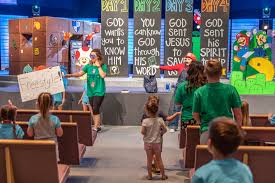 For the most hard-core religious parents, kids may be sent to private religious schools, or attend home schooling, where their kids can be isolated from “worldly” influences and given additional Biblical instruction. I went to religious schools during my elementary years, and they always taught Bible classes. These would be similar in style to Sabbath school, but these classes would also have grades and homework. Kids are given tests about various Bible stories, given even more Memory Verses, and expected to learn the names of the books of the Bible in order, as well as how to navigate their Bibles. One activity that we engaged in at my schools was called the Sword Drill. Unfortunately, this activity did not involve real swords, but instead the “Sword of the Spirit” (a.k.a the Bible). The teacher would call out a book, chapter, and verse, and everyone in the class would race to find that passage. Whoever found it first would be asked to read it out loud, and would often be rewarded in some way - usually with a piece of candy.
For the most hard-core religious parents, kids may be sent to private religious schools, or attend home schooling, where their kids can be isolated from “worldly” influences and given additional Biblical instruction. I went to religious schools during my elementary years, and they always taught Bible classes. These would be similar in style to Sabbath school, but these classes would also have grades and homework. Kids are given tests about various Bible stories, given even more Memory Verses, and expected to learn the names of the books of the Bible in order, as well as how to navigate their Bibles. One activity that we engaged in at my schools was called the Sword Drill. Unfortunately, this activity did not involve real swords, but instead the “Sword of the Spirit” (a.k.a the Bible). The teacher would call out a book, chapter, and verse, and everyone in the class would race to find that passage. Whoever found it first would be asked to read it out loud, and would often be rewarded in some way - usually with a piece of candy.
 If all that religious instruction wasn’t enough, there are a number of extracurricular Christian programs that parents can send their kids to. These may be after-school programs like youth groups, Awana clubs, or Scouts alternatives such as Pathfinders. The availability of these programs will vary from area to area. These programs will usually be similar to a VBS, but often add elements such as matching t-shirts or uniforms, and may include other activities, as well, such as camping, marching, soap box derbies, archery, and fundraising events. These programs may supplement religious schooling, or serve as a cheaper substitute for parents who cannot afford to send their kids to a private school. Like Vacation Bible School, these programs are also used as recruiting tools for churches.
If all that religious instruction wasn’t enough, there are a number of extracurricular Christian programs that parents can send their kids to. These may be after-school programs like youth groups, Awana clubs, or Scouts alternatives such as Pathfinders. The availability of these programs will vary from area to area. These programs will usually be similar to a VBS, but often add elements such as matching t-shirts or uniforms, and may include other activities, as well, such as camping, marching, soap box derbies, archery, and fundraising events. These programs may supplement religious schooling, or serve as a cheaper substitute for parents who cannot afford to send their kids to a private school. Like Vacation Bible School, these programs are also used as recruiting tools for churches.
I engaged in all of these activities as a kid at one time or another. My Biblical instruction was often wrapped up in fun activities with my friends and given to me via some pre-packaged curriculum. Other times it came in the form of cartoons and talking vegetables, or audio dramas as I went to sleep at night. I received many more hours of instruction on the Bible during my childhood than I did any other subject. While I would not call my experience typical (not many kids were as engaged with church activities as I was), it did provide me with a good perspective of the range of options available. Looking back on it now, I realize just how much time was dedicated to my indoctrination. I really did not have much of a life outside the church, which made it especially difficult when I finally decided to leave, but that’s another story for another time.
